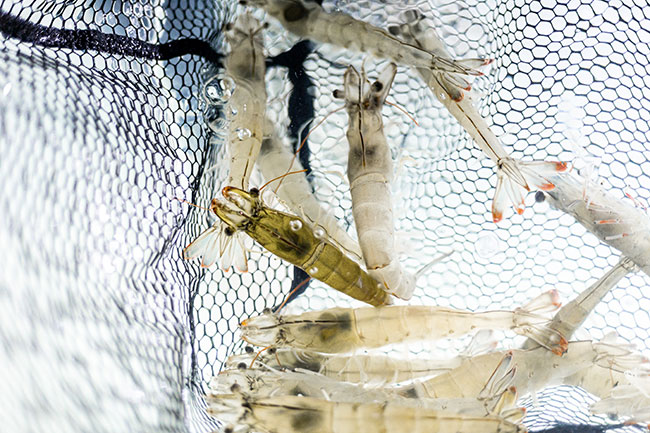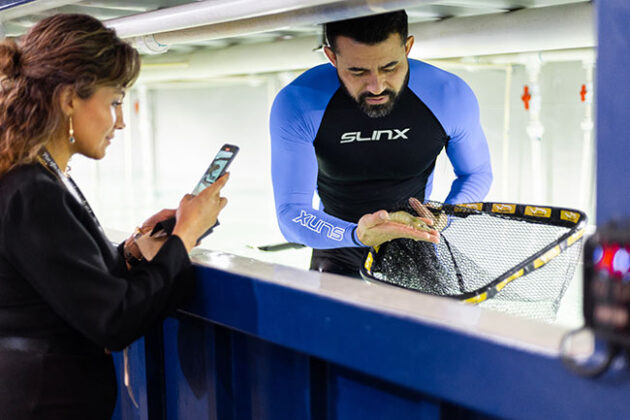
Features
Opinion
Technology
Power Struggle: The shrimp of the future is intelligently “educated”
January 22, 2024 By Maddi Badiola
 A closer look at shrimp raised in Attaraya Inc.’s AI-powered system.
(Photo: Atarraya Inc.)
A closer look at shrimp raised in Attaraya Inc.’s AI-powered system.
(Photo: Atarraya Inc.) Shrimp is one of the most widely eaten seafood in the United States where sales volume has increased from 275 to 415 million pounds per year in the last five years, and coincidentally, it is one of the most valued and consumed fish (seafood) in the Basque Country. We eat it throughout the year in great quantities, especially on special occasions such as Christmas.
In such context and talking about such a valued species with huge potential, its farming methods need to be improved to be environmentally friendly, efficiently produced and thoroughly traced.
Traditional shrimp farming has devastating environmental costs. It is here where RAS farming has great importance, and it is expanding its presence in the industry. There are already numerous RAS shrimp production companies worldwide – to name a few, Atarraya in Oaxaca, Mexico; Noray in Medina del Campo, Spain; TransparentSea in Downey, Calif.
Their farming methods are diverse – biofloc farming, Clear Water or hybrid technologies. Each manager has his/her own preferences. They show off ultra-fresh cultivated shrimp, from the tanks to the table, in a few hours.
Shrimp farming has had exceptional growth, but the industry is still plagued by many issues such as disease outbreaks, general health management and poor environmental management protocols leading to mass mortality events and disrupting the supply chain.
Also, despite the growing application of RAS technology, digital precision aquaculture has a long way to go.
Umitron, the Singaporean firm that first launched real-time, AI-based analytics solutions for shrimp farming, stated that the poor uptake and adoption of digital technology by shrimp producers has been one of the limiting factors stunting the sector’s growth, both economically and with regards to sustainability. And the sector is huge!
Every single shrimp counts as a very valued species, both economically and socially. The attention should go into analyzing and checking their real-time condition in terms of behaviour, comfortability, and happiness. Remember that a happy shrimp is a tasty shrimp!
Umitron’s technology, called Umitron Eagle, is said to use “advanced Artificial Intelligence (AI) detection to track multiple real-time biological conditions and other factors in highly turbid and intensive production environments.”
As I mentioned in my previous Power Struggle column, AI can help to reduce the energy consumption of a RAS farm by 20 per cent by improving feeding regimen and strategies. Also, it can make managers focus on operational issues that are otherwise hard to see.
AI is helping producers improve feed conversion rates (FCRs); biosecurity measures and work protocols; reducing feed waste (which contributes to undesirable environmental conditions such as poor water quality and highly turbid conditions requiring frequent water changes); and refining long-term farming management protocols and optimizing operations using the accumulated production data.

Attaraya Inc. has a model farm based in Indianapolis, Ind., USA. (Photo: Attaraya Inc.)
Oceanloop is another pioneer in shrimp farming, implemented in 2022. It is an AI-based technology that was developed by researchers and engineers. A computer-vision-based system can count the number of shrimp and measure their length at up to 95 per cent accuracy. This technology gets real-time data under actual farming conditions (i.e. high stock densities and cloudy water). Moreover, mainly due to the new animal policies in Europe and worldwide, ethical farming methods need to be applied and as such improved, and this technology directly covers it.
Atarraya Inc., a Mexican company that has invested in a model farm in the U.S. State of Indiana, shows that its system for shrimp farming can work on a large scale, producing shrimp in shipping containers powered by a computer running AI algorithms (ShrimpBox). One of their main goals is to reduce anywhere from one-third to one-sixth of the energy used to heat the water. This can allow for a very efficient and less polluting technology.
In an AI-driven aquaculture environment, the next real and important step is educating people and farmers, and this reminds me of my beginnings in aquaculture and RAS.
Aquaculture education is an ongoing topic and recurring issue. Education in every level, from management, operations, husbandry, and now digital technology, such as artificial intelligence. For example, Atarraya’s main reason to turn into AI was because it used to take four to six months to train someone to maintain the ShrimpBox. This could now be lowered to several weeks with the help of AI.
That is why I will never stop requesting more attention from the industry to educational programs. The need for an industry-based animal production system is more important than ever. Biological and digital technology are driving the world. The production companies request solutions researchers offer answers, and not vice versa.
 Maddi Badiola, PhD, PM, is a RAS engineer and co-founder of HTH Full Spectrum based in Basque Country, Spain and USA. She is executive director of the Florida Marine Aquaculture Coalition. Her expertise include energy conservation, lifecycle assessments and RAS global sustainability assessments. Email her at mbadiolamillate@gmail.com.
Maddi Badiola, PhD, PM, is a RAS engineer and co-founder of HTH Full Spectrum based in Basque Country, Spain and USA. She is executive director of the Florida Marine Aquaculture Coalition. Her expertise include energy conservation, lifecycle assessments and RAS global sustainability assessments. Email her at mbadiolamillate@gmail.com.
Print this page